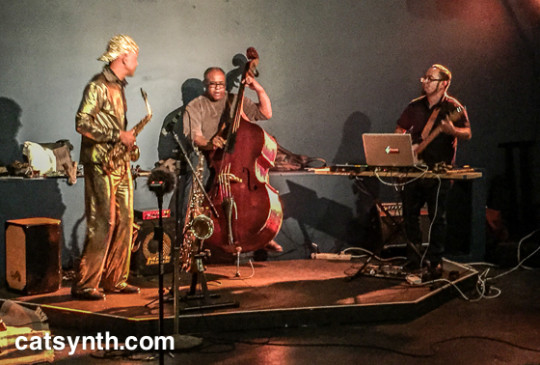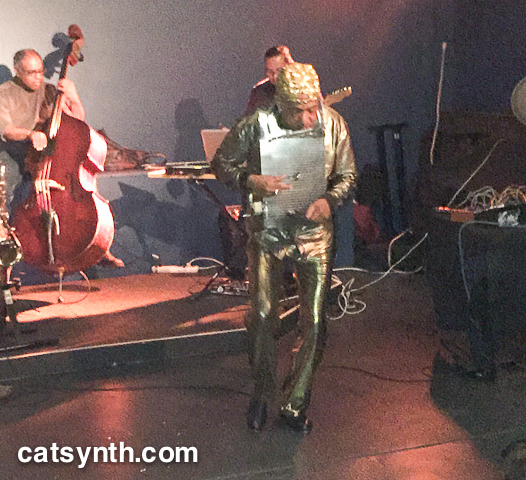The final night of the Outsound New Music Summit featured three sets combining music with visuals. The room was dark, with all illumination coming from the visuals on the screen and the sonic elements abstractly arrayed around them.
The evening opened with Mika Pontecorvo’s project Bridge of Crows performing an improvised set to a segment Pontecorvo’s film The Bedouin Poet of Mars: The Last Poet.

[Photo: PeterBKaars.com]
The film’s story is a bleak tale of a poet who is the last survivor of a once-thriving civilization on Mars, searching for a home for himself and the last surviving plant. He sees the results of several self-destructive civilizations on his journey. Despite the dark subject matter, the visuals themselves were lively and abstract at times, with lots of interesting visual and image processing.

The music moved in and out of a variety of textures and dynamic levels, though the focus remained on the visuals throughout. Joining the regular ensemble was Bob Marsh, wearing one of his trademark suits and performing on a string instrument made from a tree.

[Photo: PeterBKaars.com]
One disadvantage of the darkened environment was that I did not get to see much of Marsh or his instrument, which I would have liked to. Rounding out the ensemble were Kersti Abrams on winds, Elijah Pontecorvo on electric bass, Greg Baker on electronics, hydrophone and clarinet, Mark Pino on percussion, and Mariko Miyakawa on vocals.
Next up was Tender Buttons, a trio featuring Tania Chen on small instruments, with Gino Robair and Tom Djil on analog modular synthesizers. The trio performed sounds against live interactive video by Bill Thibault.

[Photo: PeterBKaars.com]
The set was anchored by Chen’s piano, which ranged from intricate and complex to loud and aggressive, augmented by small toy instruments. The piano interlaced with Thibault’s abstract visuals, which started out simply but grew more complex over the course of the set. Throughout, the visuals displayed words from Gertrude Stein’s poem Tender Buttons, but were increasingly mixed with the more complex elements.

[Photo: PeterBKaars.com]
Robair and Djll provided a variety of adept sounds from modular synthesizers and circuit-bent electronics to complement the piano and video.
The final set featured live interactive video by Bill Hsu with James Fei on reeds and Gino Robair returning on percussion.

[Photo: PeterBKaars.com]
I am quite from the minimalist quality in Bill Hsu’s visuals. The began with very simple geometric elements, but soon hope added a bit of controlled chaos that led to very organic elements on the screen.

Befitting the visuals, the music in this set was more sparse, with moments of quiet and loud solo bursts from Robair and Fei. Robair percussion worked best with the early geometric elements, and Fei’s complex runs on saxophone worked well with the more organic visuals.
I enjoy sets that integrate visuals and music into a single unit. It can sometimes be a challenge to take everything in, much less write about it afterwards. But I hope this gives a little insight into the evening. It was a good closing concert for this years Summit, and was appreciated by those who came only that night as well as the loyal audience members who were there most or all days. This concludes the 2015 Outsound New Music Summit, and I look forward to its return next year.






























 \
\









